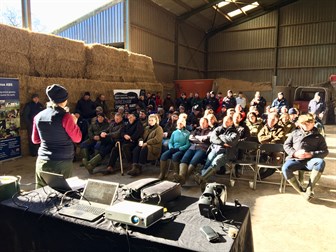Focus on calves drives performance at Chance Hall farm
Tuesday, 6 March 2018
An emphasis on calf management and investment in new facilities has helped reduce age at first calving by four months and more than double pregnancy rate at Chance Hall Farm.
Tom and Karen Halton gave an open and honest view about the management and operation at their launch as a strategic dairy farm.
The Haltons shared their current figures against eight key performance indicators, which have been identified as critical to performance for all-year-round calving systems. Scoring well in most areas, the benchmarking has identified forage as a key area for improvement over the next year.
Tom Halton said: “We want to try and be the best at what we do. We’re not set in our ways and we know there’s still room for improvement. Getting involved with AHBD enables us to show others what we do well and learn from them at the same time.”
The Haltons achieved big leaps in performance after the installation of a new 200 foot cow shed. Taking over the tenancy of the 550-acre farm in 2012 with a clear business plan helped them secure the necessary investment.
“It was like flicking a switch when the new shed went up. Fertility went up, lying times increased and both lameness and mastitis went down. Antibiotic use has halved over the last two to three years,” continued Tom.
Submission rates of 70% are helping achieve a pregnancy rate of 30%, more than double the UK average of 14%. With only 20 cows out of 540 on the barren list and 300 youngstock reared on a neighbouring farm, heifer sales are giving an additional income stream.
Using experience from a non-agricultural background, Karen created clear protocols for calf rearing, working from birth to feeding.
Karen said: “Calves are so important to us - they’re our future. If you can give them a good start in life, you’ll never see a better return in your business.”
The farm has two sheds devoted to calving, one clean and one for cows proven or suspected of carrying Johnes. Both are designed to be cleansed and disinfected down after calving and have their own milking equipment to take off the colostrum.
Colostrum is collected from the calves own dam in a dedicated bucket, tested with a refractometer and fed within an hour. Calves are weighed, moved into a dedicated ‘calf nursey’ and covered with a rug to help wick moisture away. They’re given colostrum for four to five days, as well as hard feed after 24 hours.
Such dedication is reflected in the calves’ growth rates and, ultimately, age at first calving. “We aim for growth rates of 0.8kg per day but often achieve 0.9kg. Calving age has reduced from 28 months a few years ago, to 23.8 months now” continued Karen.
Becki Leach, AHDB Knowledge Exchange Manager, said: “Tom and Karen are so passionate and proud of what they do, it’s great to be able to showcase what a top all year round calver can achieve.

Topics:
Sectors:
Tags:

